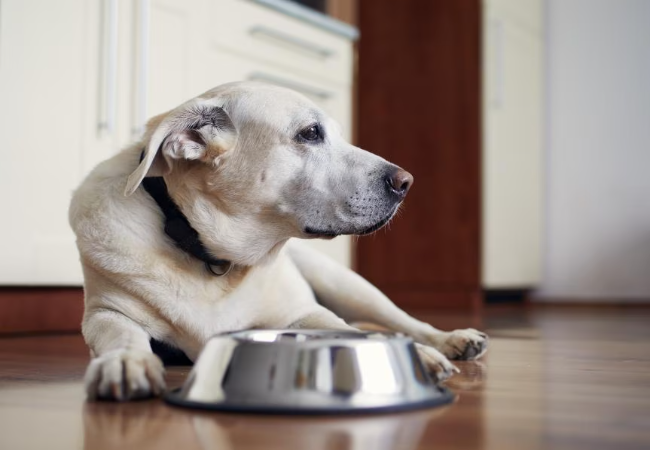A Vet’s Guide to Feeding Dogs Safely After Vomiting 2025 🐶🍲

In this article
A Vet’s Guide to Feeding Dogs Safely After Vomiting 2025 🐶🍲
By Dr. Duncan Houston BVSc
Hello! I’m Dr Duncan Houston BVSc, veterinarian and founder of Ask A Vet. Vomiting can unsettle your dog’s digestion and worry pet parents—but with a gentle refeeding plan, the right foods, and close monitoring, most dogs recover quickly and comfortably. In this vet-approved guide, we’ll cover fasting, refeeding protocols, appropriate foods, hydration strategies, and when veterinary care is essential. Let’s get your pup feeling better—safely and with care. 🩺🐾
1. Why Vomiting Happens
Vomiting can result from dietary indiscretion, mild GI irritation, minor infections, or stress. When it happens once or twice but your dog seems bright otherwise, a simple dietary reset often helps.
2. Initial Support: Fasting & Hydration
- ⏱️ Fasting: Withhold food for 6–24 hours depending on age and health—puppies and senior dogs: shorter fast (6–12 hr); healthy adults: up to 24 hr.
- 💧 Water: Ensure small, frequent sips or ice cubes to prevent dehydration—but avoid large gulps, which may trigger more vomiting.
- 📝 Observation: Watch for continued vomiting, signs of lethargy, diarrhea, appetite loss, blood, or abdominal discomfort.
3. Reintroducing Food: Bland Diet Protocol
Once vomiting stops and drinking is stable, offer small, bland meals:
- Start small: 10% of normal meal size, wait 2–4 hours.
- If no vomiting, increase to 25% and wait again.
- Further increase to 50% in same day if well tolerated.
Day 2: Offer three meals, each at 50% of normal size.
Day 3: If digestion is stable, resume normal meals in phases.
4. Recipes for Recovery
🔹 Homemade Bland Food
- Boiled, skinless chicken or lean ground beef (no bones, no fat)
- Plain white rice (or mashed potatoes) in 3:1 rice:protein ratio.
- Cook thoroughly, drain excess fat, no seasoning.
This is safe for short-term recovery, but lacks full nutritional balance long-term.
🔹 Commercial Bland & Prescription Diets
- OTC options: Blue Buffalo Blissful Belly, Royal Canin Digestive Care, Evanger’s Chicken & Rice.
- Prescription GI diets: Hill’s i/d, Purina EN Gastroenteric, Royal Canin GI—formulated for gut healing.
- Wet food is preferred over kibble for hydration and digestibility.
5. Hydration & Digestive Support
- 🧃 Use bone broth or unseasoned chicken broth to encourage fluid intake.
- Add a probiotic to support gut recovery once stable.
- Feed from a quiet, comfortable spot; try hand-feeding or food puzzles to entice eating.
6. When to Seek Veterinary Care
- 🚩 Ongoing vomiting > 24 hr or frequent bloody vomit/stool.
- Accompanied by lethargy, dehydration signs, pain, or bloating.
- If bile vomiting (yellow fluid) persists, it could indicate bilious vomiting syndrome.
In such cases, diagnostics (bloodwork, imaging, parasite tests) and medications like antiemetics or antacids may be necessary.
7. Supporting Tools & Tools for Comfort
- Ask A Vet App: Use telehealth for monitoring symptoms and adjusting diet tips.
8. Real-Life Case: Milo’s Full Recovery
Case: Milo, 5‑yr‑old Labrador with vomiting
Milo vomited twice early morning but stayed bright. We fasted him for 12 hrs, then offered 10% of a homemade chicken-and-rice meal—no vomiting. He tolerated gradual increases of a bland OTC GI diet (Royal Canin) over two days. Bone broth and probiotics added. By day 3, Milo was back on his normal adult food. He recovered fully with no further symptoms—and now uses puzzle feeders for slow, comfortable eating.
9. Long-Term Prevention & Wellness
- Feed several small meals daily to reduce gastric emptying stress.
- Avoid table scraps/garbage scavenging.
- Gradually transition diets to avoid GI upset.
- Stay alert to red flags; don’t ignore repeated bile vomiting (“upset stomach in the morning”).
📌 Final Thoughts from a Vet
With gentle fasting, a bland recovery diet, careful hydration, and gradual refeeding, most dogs bounce back within days. Remember: when symptoms persist or worsen, prompt veterinary attention is vital. Combining digestive-friendly foods, enriching feeding tools, and professional support via Ask A Vet ensures a safer, more comfortable path to recovery for your beloved canine companion. 🐾❤️






